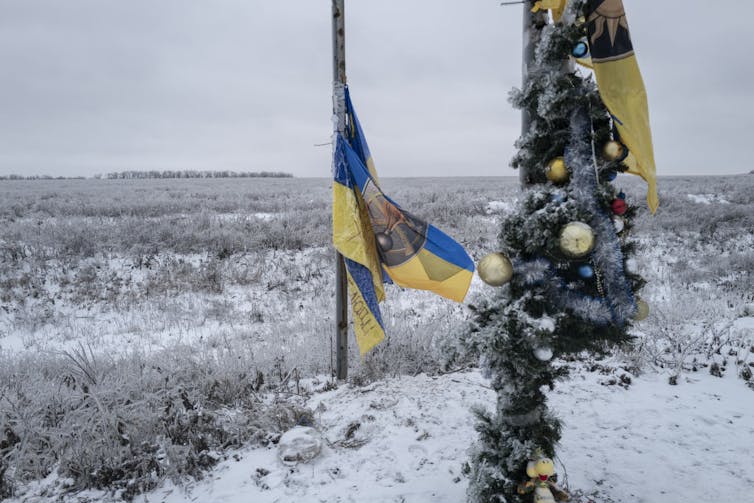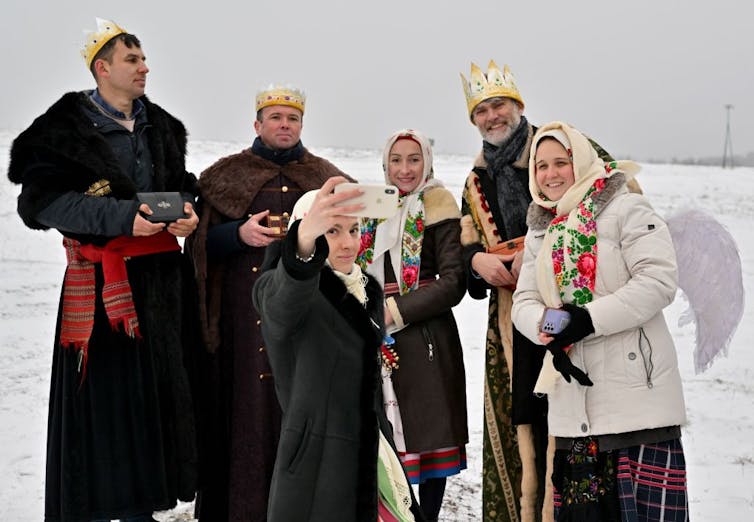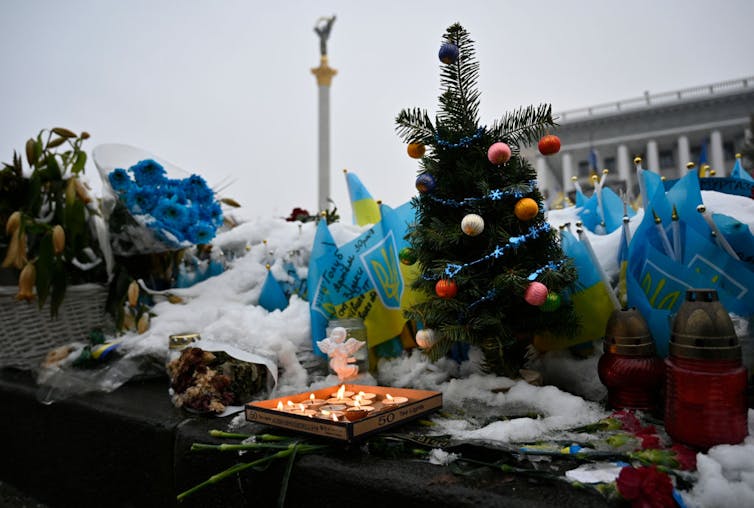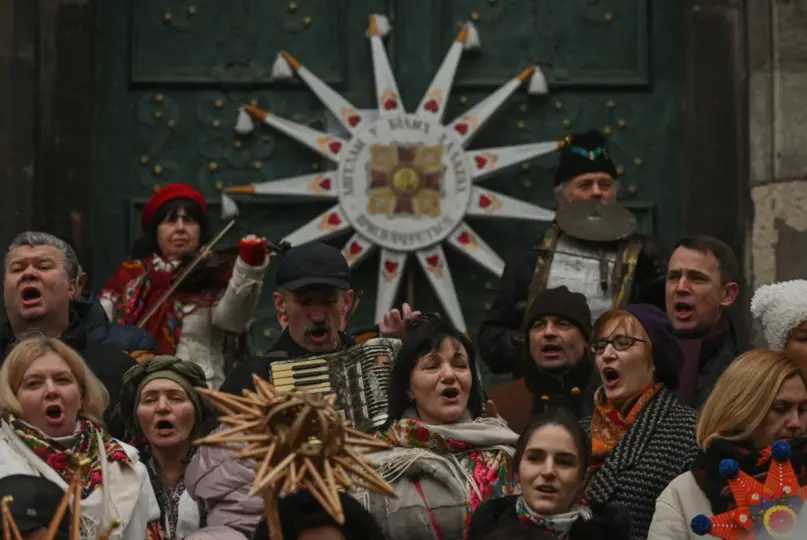(The Conversation) — This year, despite the raging war, people in Ukraine will continue celebrating Christmas – but not without politics.
In 2023, after years of debates, the Orthodox Church of Ukraine and the Ukranian government both declared Dec. 25 to be the official date for celebrating Christmas.
Traditionally, Orthodox Christians in Ukraine have celebrated on Jan. 7, in keeping with the Julian calendar that most branches of the Orthodox Church use to determine fixed-day religious celebrations. The decision to switch dates for Christmas and other holidays is one more way to assert Ukraine’s cultural and political independence from Russia since Moscow’s troops invaded the country in February 2022.
No matter what the calendar says, though, many Ukrainian traditions will continue as best as they can amid the fighting. As a folklorist and ethnomusicologist, and a native Ukrainian, I am particularly interested in how “koliadky” – Ukrainian carols – reflect the realities of the ongoing Russian war against Ukraine.

A Christmas tree close to the front line, amid intense fighting, near Bakhmut, Ukraine, in December 2023.
Marek M. Berezowski/Anadolu via Getty Images
Ancient heritage
Like in other Slavic cultures, the roots of Christmas celebrations in Ukraine reach back before Christianity itself. In 988, Prince Volodymyr the Great of the Kyivan Rus — the medieval state centered around current-day Kyiv, Ukraine’s capital — was baptized, marking the beginning of Christianity in the region.
Originally, winter festivals were mainly a celebration of the harvest from the previous year: a moment of reflection, expressions of gratitude, and hopes for another prosperous year. These themes are still widely recognizable in the koliadky.
Songs for Christmas and Malanka, another Ukrainian folk holiday around New Year’s often address members of the family: the host, their children, and sometimes even livestock and bees, who are also seen as important for a family’s and community’s well-being. Many koliadky start with greeting the host – “Good evening to you, dear host,” or “dear hostess” – and proceed with praising the couple for their hard work, embodied in the plentiful breads and other foods on the table. Holiday songs usually end with a wish of many happy years to the family.
Some carols are tailored to special social situations. For instance, there are carols for the unmarried family members – sons and daughters – wishing them to find a partner and start a big prosperous family: “May you have as many children, as there are stars in the sky.” Other carols have special messages of encouragement and support to a widow or to an orphan.
“Oh, How It Used to Be in the Ancient Times”
Some carols go so far back that they retell the Slavic creation myth, including “Oh, How It Used to Be in the Ancient Times.” The song depicts a mythical time when there was no land or sky, just a blue sea. The saints volunteered St. Peter to dive to the bottom of the sea and get some sand, to sprinkle it all over the world, so that the sky could yield stars and the Earth could yield flowers. This carol is a good example of how pre-Christian cosmology overlaps and coexists with Biblical stories about the generosity and martyrdom of St. Peter.

People perform and sing carols near Kyiv during the celebration of Malanka in January 2023.
Sergei Supinsky/AFP via Getty Images
Pre-Christian koliadky are sung alongside the carols based on the Nativity story, while the birth of Jesus and praises of the Virgin Mary are filled with Ukrainian imagery. The saints are given Ukrainian equivalents of their names, and depictions of the Nativity reflect the everyday life in rural Ukraine.
The storytelling of koliadky materialize in another important part of the Ukrainian Christmas celebration: Vertep, a folk theater play based on the biblical story of Jesus’ birth. The Vertep is typically performed by children and adults in someone’s house, or outside to gather more viewers.
Within the Vertep, which is performed with puppets, are many Gospel stories that stand out poignantly amid the war. In one scene, without blinking an eye, King Herod orders the murder of hundreds of innocent children – an attempt to kill the infant Jesus, whom he views as a threat. In another scene, the three wise men offer gifts to Jesus, Mary and Joseph – assistance from afar.
Wartime Christmas
Ukrainian artists today are also taking opportunities to demonstrate resistance through folklore. In 2022, Hey Guide, a Kyiv-based communications agency, released an album called “Ukrainian Christmas Polyphony.” Ukrainian polyphony, a form of singing with multiple parts or voices, is an object of pride in Ukrainian culture.
Along with the koliadky collected by ethnomusicologists around the country, several are newly composed. For instance, Oleksiy Zayets, an ethnomusicologist and a folk singer, offered his own carol that he dedicated to the Ukrainian Armed Forces. After each verse, the refrain repeated, “Lord, give our army good health and strength in their battle.”

Ukrainian flags with the names of fallen soldiers are visible in Independence Square in Kyiv in December 2023.
Sergei Chuzavkov/SOPA Images/LightRocket via Getty Images
Another recent project also aims to offer a fresh look at the traditional koliadky. In the 2022 Christmas film “Koliadky at Kudriavka,” the Kyiv-based folk-singing ensemble Shchuka-Ryba invited established as well as up-and-coming Ukrainian pop artists to give their renditions of Christmas songs. The film was shot at Kudriuavka, an abandoned wine factory in Kyiv, between the air raid sirens and blackouts.
The film’s message is that koliadky are not just a part of the past; they can be modern and hip. Most important, they are yet another testament to the vibrant and living Ukrainian culture that is under siege.
In preparation for Christmas, many folk-singing ensembles and researchers have offered workshops to teach general audiences some of the lesser-known koliadky. For instance, ethnomusicologist and folk singer Vira Ibryamova-Sivoraksha will host a workshop in an underground church in the Antoniy caves in Chernihiv, which are believed to be the home of an 11th century saint. In addition to the solemn environment, the location will also serve as shelter in case of an attack in the city, which is just a few dozen miles from the border with Russia, as well as the border with Russia-backed Belarus.
From Vertep performances to koliadky workshops, Christmas celebrations illustrate the resilience of the Ukrainian people. Despite the war, people continue to not only learn about their heritage, but to celebrate it – and continue a long, evolving tradition into the future.
(Iryna Voloshyna, Ph.D. Candidate in Folklore, Indiana University. The views expressed in this commentary do not necessarily reflect those of Religion News Service.)
![]()





